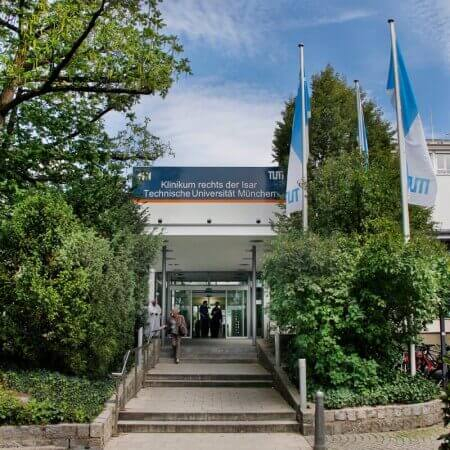A polyembryoma is a malignant ovarian germ cell tumor. This neoplasm can almost never be found in its pure form. It is one of the components of mixed germ cell tumors. The more polyembryoma in the composition, the worse the prognosis, since this type of neoplasm is aggressive: cancer cells divide rapidly, metastasize, and are resistant to radiation therapy and many chemotherapy drugs. Countries with advanced medicine, however, can achieve a good result even with this aggressive type of cancer. An early-stage polyembryoma can be completely cured, and in the advanced stage, the disease can be controlled for a very long time.
Content
- Treatment principles
- Surgical treatment
- Drug treatment
- Relapse treatment
- The cost of ovarian polyembryoma treatment in hospitals in Germany
Treatment principles
In oncology, the three main treatments for cancer are surgery, chemotherapy, and radiation therapy. Only two of the three pillars of oncology can be used for an ovarian polyembryoma. These are surgery and chemotherapy. Doctors do not use radiation therapy for this oncological disease. This is due to the fact that the tumor has a low sensitivity to radiation.
Possible treatment options for an ovarian polyembryoma depend on the stage of the pathology. Tactics may be as follows:
- surgery as the only treatment;
- surgery, followed by chemotherapy;
- chemotherapy to reduce the size of the tumor and then surgery to remove it;
- chemotherapy as a stand-alone method.
Treatment abroad usually includes a surgical stage. Doctors in countries with advanced medicine successfully cope with even end-stage cancer. A significant tumor spread requires complex surgical interventions. Nonetheless, surgery in hospitals in Germany provides good results and usually does not cause any severe complications. The level of medicine in this country allows you to count on at least a long-term remission after surgery. In many women, oncological diseases of the ovaries can be cured completely.
Surgical treatment
Doctors in hospitals in Germany usually begin treatment with an operation. The extent of the surgical interventions depends on the stage of cancer, the proportion of an ovarian polyembryoma with a mixed germ cell tumor, a woman's age and her reproductive plans, as well as the results of surgical staging. Most patients with dysgerminomas are young women, which is considered when planning treatment. Some patients wish to maintain their fertility, and others wish to avoid premature menopause.
Bilateral adnexectomy is a surgical procedure performed at an early stage of cancer. Both ovaries are removed, but the uterus is preserved. Women of reproductive age have menopause after this operation. A pregnancy is possible, but only with the help of reproductive medicine methods. A woman's own eggs are no longer produced after this operation due to the absence of ovaries. Therefore, reproductive medicine specialists can use donor oocytes or a woman's pre-frozen eggs.
Unilateral adnexectomy is another possible surgical procedure. A doctor can remove only one ovary with the fallopian tube instead of bilateral adnexectomy if the woman insists on it. In this case, the risk of recurrence increases, so close medical supervision is required in the first years after the surgical intervention. If a tumor recurs, modern medicine offers many options to cure recurrent cancer. Medical supervision facilitates the ability of a polyembryoma to produce tumor markers, so regular blood tests are sufficient to determine the signs of recurrence. Instrumental diagnostics is also necessary, and this is carried out every few months. The frequency of examinations is the highest in the first year after surgery, and then it gradually decreases. The preservation of one ovary allows a woman not only to avoid premature menopause, but also to become pregnant without the help of reproductive medicine. Unilateral adnexectomy cannot be performed if the tumor is found in both ovaries.
Radical hysterectomy is a treatment option for women who do not have reproductive plans. Doctors remove the uterus, both ovaries and fallopian tubes. Even with the assistance of reproductive medicine, a pregnancy is impossible after this operation, so a woman must make a weighted decision.
Surgical staging is performed at an early stage of an ovarian polyembryoma during any operation. Doctors examine the abdominal cavity, take swabs from the peritoneum, make a biopsy of suspicious areas, and remove some of the pelvic and para-aortic lymph nodes for a histological examination.
Cytoreductive surgery is a surgical procedure performed for advanced ovarian cancer. The objective of this surgery is to reduce the volume of the tumor as much as possible and create conditions for further drug treatment. Doctors will remove the uterus and its appendages, soft tissues in the uterus, the omentum, as well as tumor foci that they can detect. They are all removed whenever possible, and such a cytoreduction in medicine is called complete. Sometimes it is impossible to safely remove all tumor foci. In this case, doctors seek to remove at least all tumors larger than 1 cm. If there is no such tumor left, such cytoreduction in medicine is called optimal. There is also suboptimal cytoreduction. This is when tumor foci larger than 1 cm remain, but the results of ovarian polyembryoma treatment in such situations deteriorate significantly. In hospitals in Germany, the percentage of complete cytoreduction is high, so the survival rates of patients at any stage of oncological diseases of the ovaries are very good.
Drug treatment
Modern medicine offers effective drugs that inhibit the growth of malignant ovarian tumors. Hospitals in Germany use the latest medicines. Doctors prefer regimens that have proven themselves in medicine and have shown the best results in clinical trials with minimal toxicity.
Chemotherapy can be used in the following cases:
- after surgery – most women undergo therapy to reduce the risk of recurrence;
- before surgery – with significant tumor spread to reduce its size before removal;
- as the main treatment method – such an approach can be used in medicine for advanced tumors, distant metastases, and tumor recurrence.
The choice of a therapy regimen depends on the circumstances in which it is used, the stage of cancer, a patient's health condition, the proportion of a polyembryoma in the tumor, and a response to treatment. If the first-line therapy does not work or a tumor recurs within a short time after its use, a second-line regimen is used, and then a third-line regimen. In medicine, the therapy regimens VER, PEI, TIP, VeIP and others can be used for ovarian polyembryoma.
Relapse treatment
One of the biggest problems in medicine is recurrent tumors. If a polyembryoma has recurred after its initial treatment, it becomes more difficult to deal with it. With a high probability, such a tumor has metastases, and it is also less sensitive to drug therapy.
Nonetheless, doctors in hospitals in Germany often manage to cure patients even with recurrent tumors. Modern medicine offers the following treatment options:
- chemotherapy;
- surgery to remove a recurrent tumor;
- high-dose chemotherapy with a stem cell transplant (in medicine, this approach is not considered standard, but it is still being studied in clinical trials).
In about a quarter of women, doctors try to remove the tumor that has recurred. This is possible if a relapse occurred 2 or more years after the completion of therapy, in retroperitoneal localization of metastases and moderately elevated tumor marker levels, which reflect the prevalence of the tumor process.
Some women have brain metastases. These can also be removed if other tumors are absent or controlled with drug therapy.
Most patients undergoing their polyembryoma treatment in Germany get good results. Thanks to the high level of medicine, well-equipped hospitals, highly qualified doctors, and the availability of new methods and drugs, many women can cure cancer completely, while others can achieve a long-term remission of the disease.
The cost of ovarian polyembryoma treatment in hospitals in Germany
In countries with advanced medicine, the cost of medical services is higher than in countries with poorly developed medicine. But, in the end, patients who prefer to undergo their treatment in modern hospitals often have lower financial costs. This is due to the fact that they require fewer procedures and operations, as cancer is less likely to recur, and the treatment is less likely to lead to complications. As a result, patients have to undergo repeated treatment much less often, which reduces the overall cost of medicine.
In addition, when making your treatment appointment in hospitals in Germany through the Booking Health service, you will save significantly. Here is what reduces the cost of treatment:
Additional fees. These are usually applied to foreign patients, for whom the cost of treatment is higher. When making your treatment appointment through Booking Health, there are no overpayments, and the cost of medical services for you will be the same as for German citizens.
Insurance. The initial cost of treatment mostly increases after the start of therapy, and sometimes several times. But when you make your treatment appointment through Booking Health, you will not run this risk. You will receive insurance that will cover all additional medical expenses. Thus, the initial cost for you is guaranteed to not change.
Discounts. Many Departments of Oncology at hospitals in Germany reduce the cost of medical services exclusively for patients who make their treatment appointments through the Booking Health service. You can receive information about discounts in a timely manner on our website.
Trip arrangement. Large hospitals in Germany offer travel services. This is the responsibility of the international department. However, the cost of their services is quite high. If you book your treatment through Booking Health, we will arrange your trip at a much lower cost.
You are welcome to use our service to find the cost of treatment in Germany and make your appointment at a clinic at the best price. We have a convenient sorting system for hospitals: they can be sorted in descending order not only by price, but also by rating, reviews, and the next available date for a doctor's appointment. In addition to reducing the cost of treatment in Germany, you will have a chance to undergo your treatment faster, which is very important in medicine because an ovarian polyembryoma progresses, and the sooner you start your treatment, the lower the risk of the disease progressing to the next stage. Our website shows the real cost of treatment in Germany with no hidden fees and no subsequent increase after the start of your medical care program.
Authors:
The article was edited by medical experts, board-certified doctors Dr. Nadezhda Ivanisova and Dr. Sergey Pashchenko. For the treatment of the conditions referred to in the article, you must consult a doctor; the information in the article is not intended for self-medication!
Sources:
MedlinePlus
Verywell Health
Science Direct




















